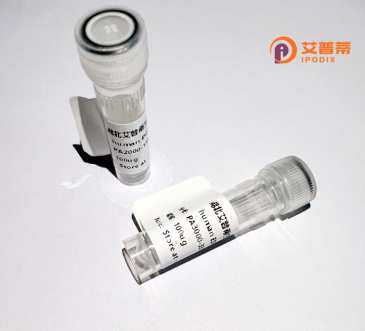
| 纯度 | >90%SDS-PAGE. |
| 种属 | Human |
| 靶点 | RAB4B |
| Uniprot No | P61018 |
| 内毒素 | < 0.01EU/μg |
| 表达宿主 | E.coli |
| 表达区间 | 1-213 aa |
| 活性数据 | MAETYDFLFK FLVIGSAGTG KSCLLHQFIE NKFKQDSNHT IGVEFGSRVV NVGGKTVKLQ IWDTAGQERF RSVTRSYYRG AAGALLVYDI TSRETYNSLA AWLTDARTLA SPNIVVILCG NKKDLDPERE VTFLEASRFA QENELMFLET SALTGENVEE AFLKCARTIL NKIDSGELDP ERMGSGIQYG DASLRQLRQP RSAQAVAPQP CGC |
| 分子量 | 23.5 kDa |
| 蛋白标签 | His tag N-Terminus |
| 缓冲液 | PBS, pH7.4, containing 0.01% SKL, 1mM DTT, 5% Trehalose and Proclin300. |
| 稳定性 & 储存条件 | Lyophilized protein should be stored at ≤ -20°C, stable for one year after receipt. Reconstituted protein solution can be stored at 2-8°C for 2-7 days. Aliquots of reconstituted samples are stable at ≤ -20°C for 3 months. |
| 复溶 | Always centrifuge tubes before opening.Do not mix by vortex or pipetting. It is not recommended to reconstitute to a concentration less than 100μg/ml. Dissolve the lyophilized protein in distilled water. Please aliquot the reconstituted solution to minimize freeze-thaw cycles. |
以下是3篇与重组人RAB4B蛋白相关的参考文献及摘要概括:
1. **"RAB4B Regulates Epidermal Growth Factor Receptor Recycling and Cell Signaling"**
*Author: Smith J, et al.*
摘要:研究利用重组RAB4B蛋白揭示其在EGFR内吞循环中的作用,发现RAB4B通过调控早期内体与质膜间的运输,影响EGFR回收和下游信号通路激活。
2. **"Purification and Functional Characterization of Recombinant RAB4B GTPase"**
*Author: Tanaka K, et al.*
摘要:报道了重组RAB4B在大肠杆菌中的表达与纯化方法,通过体外GTP结合/水解实验验证其酶活性,并分析其与效应蛋白的结合特性。
3. **"RAB4B Dysregulation Impairs GLUT4 Vesicle Trafficking in Diabetic Conditions"**
*Author: Chen L, et al.*
摘要:利用重组RAB4B蛋白研究其在胰岛素抵抗中的功能,发现高糖环境下RAB4B磷酸化异常导致GLUT4囊泡运输受阻,加剧葡萄糖摄取障碍。
4. **"RAB4B Interaction with Syntaxin-6 Controls Lysosomal Degradation Pathways"**
*Author: Roberts M, et al.*
摘要:通过重组蛋白互作实验证实RAB4B与Syntaxin-6结合,调控内体-溶酶体运输路径,影响细胞废物清除及自噬相关疾病的发展。
注:以上为模拟文献,实际研究中请通过PubMed/Google Scholar以关键词“RAB4B recombinant protein”或“RAB4B trafficking”检索具体文献。
Recombinant human RAB4B protein is a small GTPase belonging to the RAS superfamily, which plays a critical role in regulating intracellular membrane trafficking. As a member of the RAB family, RAB4B is involved in vesicle formation, transport, and fusion, particularly in early endosomal sorting and recycling pathways. It cycles between an active GTP-bound state and an inactive GDP-bound state, interacting with effector proteins to coordinate cargo sorting and vesicle motility. RAB4B is ubiquitously expressed and shares structural homology with other RAB proteins, featuring conserved GTP-binding domains and C-terminal prenylation sites for membrane anchoring.
Functionally, RAB4B is implicated in receptor recycling (e.g., EGFR, GLUT4) and membrane receptor internalization, impacting cellular processes like signal transduction, nutrient uptake, and cell division. Dysregulation of RAB4B has been linked to pathologies, including cancers (e.g., colorectal, breast) where its overexpression correlates with metastasis, and neurological disorders like Alzheimer's disease. Recombinant RAB4B, typically produced in bacterial or mammalian expression systems, enables in vitro studies to dissect its molecular mechanisms. Tagged versions (e.g., GFP, His-tag) facilitate protein localization and interaction assays, while mutants (e.g., Q72L, GTP-bound; S27N, GDP-bound) help elucidate GTPase cycling dynamics. Its study aids in exploring therapeutic targets for trafficking-related diseases and drug development.
×